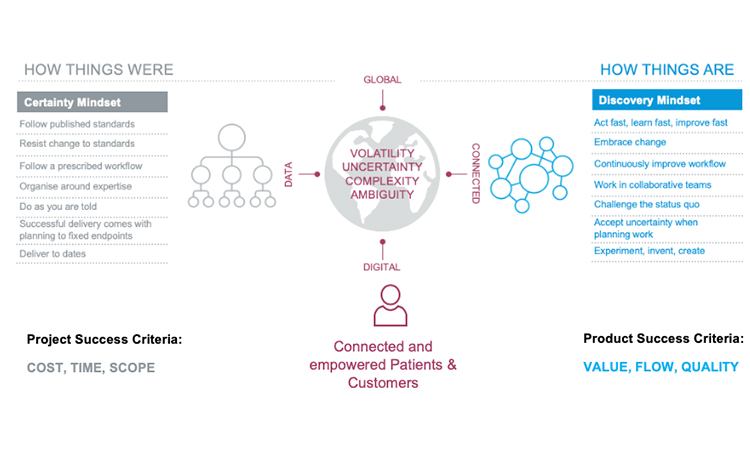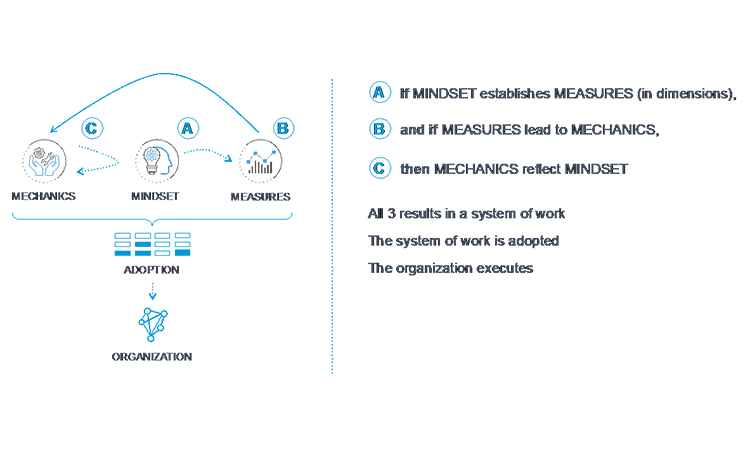Agile Software Development in GxP Regulated Environments GAMP® Special Interest Group

Then and Now – From Certainty to Discovery Mindsets
Advancement in technologies have forced organisations to rethink business models. Organisations that were once controlled and orderly are now more chaotic and complex, serving patients and customers that are better informed and with higher expectations than ever before.
Patients can go online and research symptoms, possible causes, and potential treatments. And with the huge global market of wearable health technologies, people have never been so informed of their health data.
To succeed with this changing dynamic, not only do our work practices and tools need to change, but it also requires a change in people's behaviors and management systems for the improvements to be sustained.
Mindset

Mindset describes how the organization thinks. It’s about how culture, values and priorities manifest themselves throughout the organization. Does your thinking reflect a traditional mindset – one with fixed standards, workflows, and expectations – or a discovery mindset, which encourages acting, learning or fast improvement?
Mechanics

Mechanics describes ‘what we do’ as an organization. The processes and practices that staff use each day to do their jobs. This also covers various tools and technologies that are relied upon to get work done.
Measures

Without the appropriate organizational support, such as leadership, policies and governance, any transformational effects will be short-lived. Measures is about understanding the effects of management on the performance of improvements.
Within this blog, we will just be talking about the difference in Mindsets, but in future blogs we will also address the Measures and Mechanics.
One way to see the difference is by looking at the different strategies and mindsets used by the previous and current approaches to delivery.
Certainty Mindset drove long term fixed strategies:
Waterfall programmes and projects have often been focused on the company’s needs, rather than the end customers. Often, they were opinion driven by the HIPPO (Highest Paid Person’s Opinion) that a given strategy was right rather than the result of research and data. “We must move to the cloud!”
Average release cycles measured in quarters or years, often being such large releases that the users needed extensive and time-consuming training on the new systems.
There was and still is a perception that we can estimate and predict the distant future, even though it’s typical for project managers add in a contingency buffer, which is often added to by their boss, which further increases the original estimated timeframes.
How many large waterfall programmes or projects have you been on where the end date must not move, and so the final testing phases are squashed and reduced because earlier phases over ran?
It’s not Waterfall that is the issue, as clearly there are countless examples of Waterfall projects being successful. The issue is the certainty mindset and how it is enticing to think the world is certain, and not undergoing constant change.

Discovery Mindset drives dynamic strategies:
With the Discovery Mindset we are embracing the constantly changing environment and the uncertainty of everything. During 2020, we are in a global pandemic that has significantly changed and challenged every individual and every company across the globe. Those companies that were quick to pivot to the new normal are the ones succeeding now.
Today more than ever we need to be Patient/Customer orientated and data driven. Patients have choices, they are better informed, they have embraced a digital world. A digital world where they expect their apps and devices to constantly update with minor/micro changes. They expect intuitively designed products that don’t need training courses to know how to use them. And they are quick to replace products that don’t match these expectations.
These patients/customers are no different to our workforce who want that consumer grade experience with the internal systems we use.
A recent example of how the discovery mindset that embraces change helps for those unplanned events, together with how patients are embracing digital, is how patients are trying to see their family doctor during these pandemic times, was researched by the Royal College of General Practice:
The current guidance on NHS.uk is for patients to avoid going directly to their GP in person, but to phone or use online services to contact their GP surgery for advice about how to access care. Patients are told they will only be asked to visit the surgery if absolutely necessary and are warned that ‘you may have to wait longer than usual to speak to someone if it’s not urgent’.1
According to a survey conducted with 1,000 GPs by the Royal College of General Practice, reported on 19 April, the majority of consultations were taking place via phone or video call.1
In order to achieve this Discovery Mindset, we need to look at the long-term goals, but get there through small effective changes, predicting and estimating the near future. Making fast decisions driven by multiple data points to allow early and frequent pivots.
Follow the target as it moves, instead of fixing on its original point and then missing it.

It might appear that Discovery Mindset can’t work in our regulated industry. We are accustomed to processes and procedures that, we think, constrain us into a Certainty Mindset. That is, gathering all requirements together and getting them signed-off: design and sign-off; building the system and, when it’s finally ready; testing it. Along the way, producing a mountain of evidence to show what our plan was, how we executed, and finally what (if any) deviations occurred.
Alternatively, we can achieve the same levels of GxP Compliance, governance, evidence, and be auditable and audit ready, while embracing the Discovery Mindset. This is simply because processes are the Mechanics of what we do, not the Mindset in which we do it.
Every successful agile adoption or transformation is specific to the organizational culture, history, technology and people. As mentioned earlier in the blog, this requires not only our work practices and tools to change, but a change in people's behaviours and management systems, for the improvements to be achieved and sustained.
However, there are a common set of principles that cut across these:
- An agile-first mindset and ways of working, using a Discovery Mindset, rather than Certainty Mindset
- A culture of innovation and continuous improvement
- Empowered teams with the ability to delivery across geographies
- A consistent and repeatable way of agile delivery
- Much-improved alignment across all the stakeholders
The discovery mindset might feel uncomfortable to those of us used to driving for the certainty of regulatory compliance and safe, effective and efficacious products. However, much of today’s certainty is based upon years of previous discovery. By acknowledging that complexity makes it hard to accurately predict the future and change is certain, the discovery mindset enables us to manage learning and adaptation throughout the development lifecycle in a controlled way. Embracing change, in a controlled manner, throughout the development lifecycle aligns with Quality Management principles, regulatory requirements and helps to increase the safety of systems, products and therefore patients.
Mark Whelan - Lead Quality Specialist – Technology Assurance and Change Programmes NHS Blood and Transplant
The Discovery Mindset is a powerful approach to changing how we plan and deliver. On its own, it will help any team with continuous learnings. But its real power comes when we also look at changing how we Measure success and the Mechanics of how we deliver. Such as looking at the Value delivered to the company and meeting the needs of our patients and customers, rather than the cost of delivery. Or the frequent production releases instead of annual releases.
In the next blog post on the Mechanics of managing User Requirements, we will cover the Certainty mindset of why we try and gather all requirements up front and why approvals are needed. Plus, how we can achieve the same levels of governance, but in a different way that enables us to do agile.
iSpeak Blog posts provide an opportunity for the dissemination of ideas and opinions on topics impacting the pharmaceutical industry. Ideas and opinions expressed in iSpeak Blog posts are those of the author(s) and publication thereof does not imply endorsement by ISPE.
View related articles:





